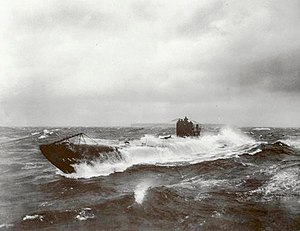 UB-148 at sea, a U-boat similar to UB-109.
| |
| History | |
|---|---|
| Name | UB-109 |
| Ordered | 6 / 8 February 1917[1] |
| Builder | Blohm & Voss, Hamburg |
| Cost | 3,714,000 German Papiermark |
| Yard number | 315 |
| Launched | 7 July 1917[2] |
| Commissioned | 31 December 1917[2] |
| Fate | Sunk by mine on 29 August 1918 at 51°3′N 1°44′E / 51.050°N 1.733°E[2] |
| General characteristics [2] | |
| Class and type | Type UB III submarine |
| Displacement | |
| Length | 55.30 m (181 ft 5 in) (o/a) |
| Beam | 5.80 m (19 ft) |
| Draught | 3.70 m (12 ft 2 in) |
| Propulsion |
|
| Speed |
|
| Range |
|
| Test depth | 50 m (160 ft) |
| Complement | 3 officers, 31 men[2] |
| Armament |
|
| Service record | |
| Part of: |
|
| Commanders: |
|
| Operations: | 3 patrols |
| Victories: |
7 merchant ships sunk (14,092 GRT) |
SM UB-109 was a German Type UB III submarine or U-boat in the German Imperial Navy (German: Kaiserliche Marine) during World War I. She was commissioned into the German Imperial Navy on 31 December 1917 as SM UB-109.[Note 1]
UB-109 was sunk by mine in the English Channel on 29 August 1918[2] and underwater scanning of the area covered by the Dover Barrage shows her wreck broken in half.[4]
- ^ Rössler 1979, p. 66.
- ^ a b c d e f Gröner 1991, pp. 25–30.
- ^ Helgason, Guðmundur. "WWI U-boat commanders: Kurt Ramien (Royal House Order of Hohenzollern)". German and Austrian U-boats of World War I - Kaiserliche Marine - Uboat.net. Retrieved 9 March 2015.
- ^ "The Maritime Archaeology of the Dover Barrage". Wessex archaeology on line. Retrieved 1 September 2015.
Cite error: There are <ref group=Note> tags on this page, but the references will not show without a {{reflist|group=Note}} template (see the help page).